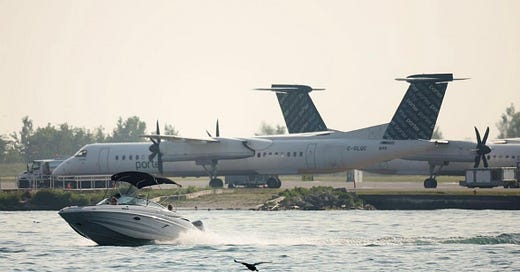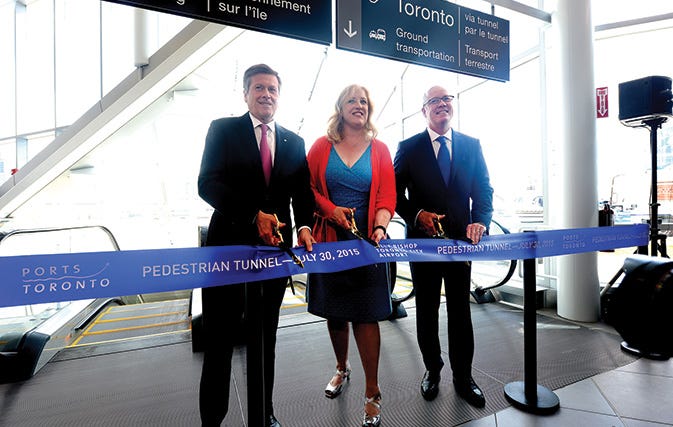Given how important this issue is to many Torontonians, I wrote a piece for The Star on Billy Bishop airport’s future. As I’m not space-constrained here, I’ve done a “long form” version of the topic that is as much as “Explainer” as it is an “Opinion Piece.”
Like its namesake Billy Bishop, Toronto’s downtown airport is used to getting shot at. As with every air battle, fortunes ebb and flow based on the players involved and the prevailing winds.
My colleague Edward Keenan thinks “we need to have that talk about Billy Bishop airport.” and reflect on whether or not it should exist “25 or 50 years from now.” As a former Chairman of the federal entity that owns the airport – and the guy who got the $82.5 million underwater pedestrian tunnel built at no cost to taxpayers in 2015 – I’m happy to engage.
The last time the airport’s future was a hot topic, 90 per cent of Torontonians thought that Billy Bishop Toronto City Airport was an “asset” to our city. With that level of support, you might ask yourself why we are wasting even 60 seconds debating whether or not the airport should be allowed to operate beyond 2033.
The answer is easy, and all roads lead to City Hall. As an NDP MP, Olivia Chow vowed to close the airport. Once Porter Airlines launched in 2006, she called on her Parliamentary colleagues and federal bureaucrats to “boycott” the new upstart – despite the fact that Porter’s mere existence had lowered airfares for consumers.
Since that time, Billy Bishop’s commercial passenger loads have increased from less than 25,000 to two million annually. Convenience has driven this outstanding growth, making it one of Canada’s 10 busiest airports.
If Mayor Chow had her way in 2006, and Porter hadn’t given Air Canada and Westjet some needed competition, your plane ticket to cities such as Ottawa, Montreal, Halifax and Newark would have cost hundreds of dollars extra for the past 18 years.
City Hall staff have never been fans of Billy Bishop Airport, and with Mayor Chow as their boss, they were bound to recently recommend against extending the airport’s life beyond 2033. And don’t be distracted by Mayor Chow’s support of PortsToronto “fixing the runway,” when she has never recanted her opposition to the airport’s actual existence.
Torontonians have had almost 20 years to get used to what a thriving, quiet, efficient Billy Bishop looks like. What will be learned during the “long conversation” about the airport’s future that Mayor Chow says she favours?
Given the long list of challenges facing Canada’s largest city right now, I’m surprised that anyone would consider putting over 2,000 people out of work, kiss away millions in taxes and royalty payments to City Hall and Ottawa each year, and risk the $2.1 billion in total annual economic output that Billy Bishop generates for the GTA.
But, if everyone wants to have a genuine “conversation,” here are the issues that you’ll be hearing more about in the coming weeks:
Can’t Toronto survive with just Pearson Airport?
In 2023, Billy Bishop was named by Skytrax as one of the world’s top ten best airports (under five million passengers). Over at Pearson, J.D. Power’s 2024 satisfaction survey ranked it 19th out of 20 “mega” North American airports. Second from last – and passengers pay Pearson more than $1.5 billion in annual airport improvement fees.
Despite predictions (Editor’s note: wishful, no?) by its haters, passenger volumes at Billy Bishop haven’t been negatively impacted by the opening of the Pearson UPExpress in 2015.
Even with Billy Bishop’s consistent popularity, over a million Canadians made the trek to Buffalo last year to catch a flight. Buffalo-Niagara International Airport spent $8 million in 2009 to expand its parking lots to deal with the fact that Canadian vehicles had come to represent 47% of the airport’s long term parkers, up from 8% in 2002.
Canadian families clearly want transportation choices.
Why don’t we close Billy Bishop and add it to the existing Toronto Island park?
Originally envisioned as Toronto’s “main” airport as Malton suffered from fog, Billy Bishop was built in the early 1930s on what was largely a reclaimed silty swamp – not parkland.
The Toronto Islands comprise 820 acres, which is similar in size to New York’s Central Park, and about twice as large as Toronto’s High Park. Primarily a park, it is home to private yacht clubs, a school, a ferris wheel, a church, a fire hall, a water treatment plant and 262 individual residences.
This generation’s members of the anti-Billy Bishop lobby group Community Air want to turn the airport into more greenspace. They never explain why – if Toronto needs more parkland – they would preserve 262 private homes on Toronto Island, which cater to the subsidized lifestyle of a few hundred people at below market rates, while closing Billy Bishop, which serves more than two million users a year and supports thousands of jobs. (Editor’s note: Is that because many of BBTCA’s detractors are also cushy Island residents?)
Moreover, unlike Billy Bishop, which is self-financed, Toronto taxpayers spend more than $10 million annually to subsidize the dedicated 18-hour/day, 12-months a year, dedicated ferry service to the 262 homes on Algonquin Island. That’s $10 million that isn’t being spent on the homeless, but on the quaint cottage lifestyle of a privileged few.
Runway End Safety Area construction
As a subsidiary of PortsToronto, which is a Government Business Enterprise, Billy Bishop Airport must be self-sufficient financially. Commercial airline passengers pay almost 100% of the costs of running the airport, which includes keeping the runways in shape, running ferries and paying the annual cost of the Public-Private Partnership (P3) underground tunnel.
If you’ve never had to borrow tens of millions of dollars to build public infrastructure in Toronto, I can understand why you wouldn’t be familiar with the reality of the debt market. No lender will be comfortable providing a 25-year loan to an airport that is slated to close in nine year’s time.
Mayor Chow knows this, making her support for the safety measures hollow if PortsToronto can’t finance the project due to the City’s refusal to extend the lease beyond 2033 – an extension that would allow the airport operate on a status quo basis going forward.
How does the Tripartite Agreement work?
This 1983 agreement governs the airport, and is one of the toughest in the world.
It limits the amount of noise the airport can generate each year, which caps noise generation based upon the airport’s busiest 21 days each year. This noise ceiling represents one of the most strict noise regimes globally, and takes into account 2,600 annual lifesaving medevac helicopter movements as well as general aviation use.
Unlike Pearson, Billy Bishop is closed to private and commercial flights between 11:00 p.m. and 6:45 a.m. This rule mitigates Billy Bishop’s impact on its neighbours.
That means no passenger jets or overnight commercial landings, unlike Pearson, which often sees ~100 overnight commercial take-offs and landings while Billy Bishop is closed. There are even restrictions on Billy Bishop’s operations during the key “quiet hours” of 6:45- 7:00 a.m. and 10:00 -11:00 p.m — unlike Pearson.
Isn’t Billy Bishop bad for neighbouring real estate prices?
In May 2002, the late Allan Sparrow, the former head of the anti-airport lobby group Community Air, was reported in the Toronto Star as predicting that Porter’s arrival would cause property values to plummet as much as 25%, and jeopardize some $20 billion in waterfront redevelopment.
But what actually happened?
The redevelopment went ahead just the same, and Waterfront condo values rose more than 70% between 2003 and 2013, mirroring the rise in average home prices across Toronto. In fact, condos prices in the C1 market (near Billy Bishop) rose 10% more than C8 (east of Yonge Street), even though C1 is closer to the airport.
Is Billy Bishop bad for the environment?
Billy Bishop is one of the most environmentally sensitive airports in the world. As Chairman, I ensured that the airport became powered by Bullfrog Power’s 100% green electricity in 2010. Not only was it the first airport in Canada to make this commitment, it was the first federal agency to do so.
Given the airport’s location, 41% of passengers choose to walk, bike, take a shuttle or the TTC when they use Billy Bishop. That’s great for all.
Recently, PortsToronto partnered with the City of Toronto on an air pollution study of the Bathurst Quay neighbourhood. The air was found to be 30 per cent cleaner than the Toronto average. That’s a byproduct of 20 years of careful planning and mitigation by the airport’s operator.
As for noise, over the past 15 years, PortsToronto has taken meaningful steps to reduce the effects of airport noise on its neighbours. Initiatives include the installation of acoustic barriers at the airport, a noise management office that follows international best practices, state-of-the-art flight-tracking technology, the publication of monthly noise reports, and a special noise-reduction building that houses the Turboprop aircraft during servicing.
As for the carbon footprint of the Turboprop Q-400s that fly out of Billy Bishop, they produce 35% lower CO2 emissions than competing regional jets, and 50% lower CO2 emissions than narrow body jets. When compared to similarly-sized regional aircraft, the Q-400 has the lowest fuel consumption and CO2 emissions per passenger.
Who thought it was a good idea to build an airport on Toronto Islands in the first place?
Originally envisioned as Toronto’s “main” airport as Malton suffered from fog, Billy Bishop was built in the early 1930s on what was largely a reclaimed silty swamp — not parkland.
One of the countless fibs that former City Councillor Adam Vaughan would tell about Billy Bishop airport while in office was that it was built beside a residential neighbourhood. That wasn’t true, and as TPA Chairman I would regularly send him archival photographs of the area and excerpts from historical documents to remind him that the airport had been built beside industrial land. As you’d imagine, he ignored anything that didn’t fit his yarns; and, yes, I eventually forgave him.
Facts don’t always matter to the airport’s haters — something that you need to be aware of as this debate heats-up.
Mr. Keenan seems satisfied with the airport existing “today,” but wonders “about 25 or 50 years from now.” On that front, I’ll defer to urbanist Richard Florida, who argues: “We should be doing all we can to create a neighbourhood-friendly, walkable and sustainable downtown airport…. If Toronto is serious about becoming a global city, it needs to act like it.”
During a swing through Toronto on a business development trip when he was Governor of Massachusetts, Deval Patrick (a Democrat) called Billy Bishop “a jewel.” “Connections actually matter,” he advised a Toronto luncheon audience.
Keep that in mind when Billy Bishop’s few, noisy detractors claim to have Toronto’s best interests at heart.
MRM
(this post, like all blogs, is an Opinion Piece)
(photo below, credit: PortsToronto 2015 official opening of the pedestrian tunnel)






Thank you for your article. This was a very informative read. I agree with all your points.
I love Toronto Island Airport. It is sustainable in a way Pearson can never be. I hope for its future. I also hope its detractors will just die away. God help us all with Olivia Chow at the helm. God bless Billy Bishop Airport and to you for defending it.
Scott L.